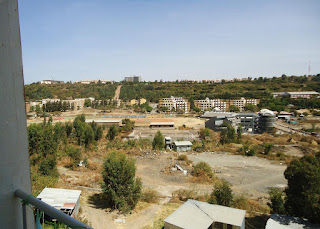Despite bumps, Ethiopia PJ project achieves goals
(GONDAR, ETHIOPIA and PARKVILLE, MISSOURI USA)-Whenever you close out a grant
project, granting agencies always require a cascade of data that demonstrate
and measure the ways that the grant has succeeded. Instead, I prefer to go with
my gut as I evaluate the success of this semester-long peace journalism
project. I know you will excuse (embrace?) my lack of complex data-filled charts.
First, a quick overview: In the fall of 2017, I was
named a U.S. Senior Subject Specialist for Peace Journalism in Ethiopia. This
project was launched by the Center for Global Peace Journalism at Park
University, the U.S. Embassy-Addis Ababa, and the University of Gondar (UoG).
I came to Addis Ababa in mid-January, and taught
several workshops there before moving on to Gondar. At UoG, I taught two
courses, and also presented a peace journalism seminar in April. From my Gondar
base, I traveled to Bahir Dar (February), Hawassa (March), and Mekelle (April)
to deliver peace journalism workshops for university students, professors, and
professional media staff. In total, my peace journalism seminars reached about
310 students, academics, and journalists.
In general, the audiences at these
events were receptive to the idea of peace journalism. I had a number of
journalists comment that there are aspects of PJ that they appreciated and would
endeavor to implement. Even journalists from State Radio/TV in Hawassa were
receptive to PJ. There, we talked about PJ and state media. Attendees,
reporters and managers, listed potential benefits of state media for PJ. These
included access to many different people and cultures; access to government
leaders and decision makers; and better resources than private media. The
discussion got really interesting when we talked about how state media structures
might provide an obstacle for PJ. These are the disadvantages the attendees
said state media pose for peace journalism: Inability to criticize the
government; interviewees reluctant/afraid when dealing with state media;
censorship; and inability to balance stories with opposition voices.
These meetings and workshops were
arguably the most successful aspect of the project. At each location, we drew a
good, engaged audience (75 or so in several instances), along with lots of
favorable local press coverage.
My classes at UoG produced more mixed results
because most of the students didn’t possess the requisite English skills to
fully understand the course content or excel at projects and tests. My departmental
colleagues have also noted the students’ substandard English, so this is more
than just my whining. In both classes, 95% of the feedback I got from students
was a simple “I don’t understand” or “Can you explain this again?” In my report
to the U.S. Embassy, I wrote that despite this, I still recommend placing other
American journalism academics at UoG. To address the English deficit, I
suggested that that students enrolled in any American professor’s class be
required to concurrently enroll in a parallel English language lab, or utilize
systematic tutoring.
My other major initiative was my scholastic
journalism project, and it was, pardon my lack of humility, an unqualified
success. I worked with a group of seventh graders at the University of Gondar
Community School. For about two months, my co-advisors Peggy Landers, Habtie
Marew, and I met with the kids once a week to present the basics of journalism
and peace journalism and of producing a newspaper. Then, the students organized
themselves into a newspaper staff, and went out to report, shoot pictures, etc.
Using these materials, they produced their school’s first student newspaper, in
English. (Click here to see the newspaper) I was thrilled by the work of the
students, and by their enthusiasm. I was even more thrilled when, during our
last meeting, the newspaper staff began planning for the second issue of their
newspaper.
Overall, I believe the project achieved its goals,
and provided a good foundation for peace journalism in Ethiopia. I hope to
continue working with the UoG journalism department; in fact, we have applied
for a joint grant for a media literacy project. And one way or another, I’d
love to continue assisting the community school’s enthusiastic seventh grade
journalists.
NEXT: In part two of my Ethiopia wrap up, I’ll get a
bit more personal: What will I miss (hint: think beans), and what won’t I miss
(hint: scattered animal parts).
